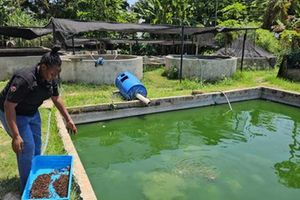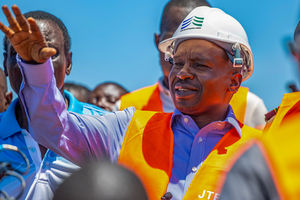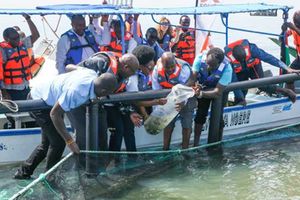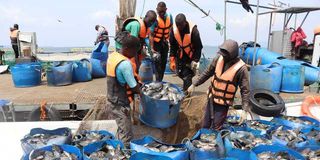
One of the fish ponds owned by Victory Farms used in producing eggs and fingerlings.
A decade ago, Joseph Rehmann and Steve Moran walked to Roo Valley, Homa Bay County, and stumbled on a treasure.
For residents of Kaksingri, the landscape and the water at the bottom of the valley were ordinary natural features they grew up seeing.
For Rehmann and Moran, it was the ideal place to establish a company that would later become one of the leading suppliers of tilapia in Kenya.
The two are the founders of Victory Farms, which produces up to 35 tonnes of fish a day. The company uses cages in the production of fish.
Eggs are hatched and the juvenile fish put in ponds on land. Weeks later, they are moved to the lake and put in cages until they mature.
This idea has been embraced by farmers in Siaya, Migori, Kisumu and Busia counties. Cage fish farming has helped improve the country’s growing demand for protein.
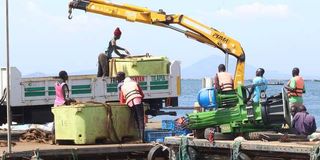
Workers at Victory Farms load fish from a boat to a truck at Roo beach in Suba South, Homa Bay County.
During a tour of Victory Farms in October 2023, President William Ruto gave it the greenlight to expand.
Victory Farms is now building a fish processing centre, with the main export market being Europe. Fish waste will be used to make livestock feed.
To ensure optimum operations and a steady supply of fish alongside making feeds, the company is looking for new places to set up more cages.
Moran says Victory Farms will have cages in Migori and Siaya.
“The new processor is the next step in our journey,” he says.
Victory Farms Chief Development Officer, Caesar Asiyo, says having the processor would be a milestone for the company.
“It is the first major investment outside of our core farm area,” he says.
The Sh140 million Suba Value Addition Centre is the largest in the Lake Region and will be capable of processing 120 tonnes a day.
Victory Farms does not have the capacity to produce that amount so it is exploring other options of getting fish.
Moran says the plant will also process ochonga (reddish shrimps) to make animal feeds.
The plant will process soybean as an ingredient for the animal feeds too. Scales, intestines and other fish waste are to be included in the production of feed.
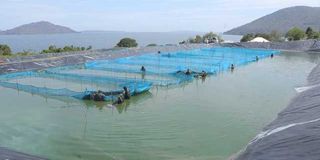
Fish cages at Rasira Beach in Suba South, Homa Bay County.
Fish scales are rich in collagen, a protein that provides structural support to body tissues like skin, tendons, bones and cartilage.
“Ochonga has a lot of proteins and minerals like calcium, making it a valuable component in formulated feeds,” Asiyo says.
Despite farmers using it to supplement poultry feed, fishermen say it does not fetch a lot of money.
It is often sold alongside or as a substitute for omena (Lake Victoria sardine), which is a well-known high-protein feed.
Farmers give unprocessed shrimps to poultry but some birds do not eat it.
Victory Farms will use the reddish shrimps and fish waste as ingredients for the livestock feed.
“At some point, we will inform residents which crops we are interested in and encourage farmers to plant them. We will set up collection centres for ochonga,” Asiyo says.
The ingredients will be dried and crushed before being taken to the mill for final processing. The company has also established a branch in Rwanda.
Homa Bay Fisheries Executive Sarah Malit says the processor will improve the economy of the region. She advises farmers and fishermen to support the firm, saying its growth will create jobs and spur development.
Joash Aloo, the County Trade and Investment Executive, says the processor signifies growing investor confidence in the potential of Homa Bay County.
He says it will position the county as a leader in fish meal production and the blue economy, boosting businesses and exports.
“It is a testament to what strategic partnerships can do in advancing industrial growth and sustainability. The processor will create direct and indirect jobs in the fish value chain – from transport, processing, supply and other services,” he says, adding that Homa Bay has ample land for more investments.

